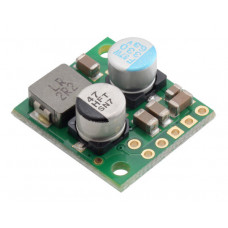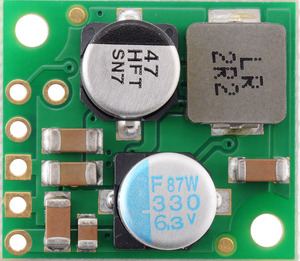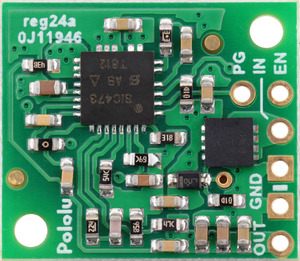3.3V, 3.6A Step-Down Voltage Regulator D36V28F3
Description
This small synchronous switching step-down (or buck) regulator takes an input voltage from 4.5 V to 50 V and efficiently reduces it to 3.3 V. The board measures only 0.7″ × 0.8″ yet delivers typical maximum continuous output currents between 3.2 A and 4.5 A, depending on the input voltage, which makes it well suited for powering moderate loads like sensors or small motors. An optional enable input can be used to put the regulator in a low-power state with a current draw of 10 µA to 20 µA per volt on VIN. The regulator also features reverse voltage protection and a power-good output that indicates when the regulator cannot adequately maintain the output voltage. The pins have a 0.1″ spacing, making this board compatible with standard solderless breadboards and perfboards.
The D36V28Fx family of buck (step-down) voltage regulators generates lower output voltages from input voltages as high as 50 V. They are switching regulators (also called switched-mode power supplies (SMPS) or DC-to-DC converters), which makes them much more efficient than linear voltage regulators, especially when the difference between the input and output voltage is large. These regulators can typically support continuous output currents between 2 A and 4 A, depending on the input voltage and output voltage (see the Maximum continuous output current section below). In general, the available output current is a little higher for the lower-voltage versions than it is for the higher-voltage versions, and it decreases as the input voltage increases.
The regulators have reverse voltage protection up to 40 V, output undervoltage and overvoltage protection, over-current protection, and short-circuit protection. A thermal shutdown feature also helps prevent damage from overheating and a soft-start feature limits the inrush current and gradually ramps the output voltage on startup.
Details for item #3781
|
|
Features
- Input voltage: 4.5 V to 50 V (minimum input subject to dropout voltage considerations for currents over 4 A;
- Output voltage: 3.3 V with 4% accuracy
- Typical maximum continuous output current: 3.2 A to 4.5 A
- Typical efficiency of 80% to 90%, depending on input voltage, output voltage, and load
- Switching frequency: ~500 kHz under heavy loads
- Power-save mode with ultrasonic operation that increases light load efficiency by reducing switching frequency, but keeps it above the audible range (20 kHz)
- 2 mA to 3 mA typical no-load quiescent current
- Enable input for disconnecting the load and putting the regulator into a low-power state that draws approximately 10 µA to 20 µA per volt on VIN
- “Power good” output indicates when the regulator cannot adequately maintain the output voltage
- Output undervoltage and overvoltage protection
- Soft-start feature limits inrush current and gradually ramps output voltage
- Integrated reverse-voltage protection up to 40 V, over-current and short-circuit protection, over-temperature shutoff
- Compact size: 0.7″ × 0.8″ × 0.345″ (17.8 mm × 20.3 mm × 8.8 mm)
- Two 0.086″ mounting holes for #2 or M2 screws
Connections
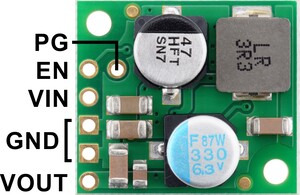 |
This regulator has six connections: power good (PG), enable (EN), input voltage (VIN), output voltage (VOUT), and two ground (GND) connections.
The “power good” indicator, PG, is an open-drain output that goes low when the regulator’s output voltage either rises more than 20% above or falls more than 10% below the nominal voltage (with hysteresis). An external pull-up resistor is required to use this pin.
The EN pin is pulled-up to reverse-protected VIN by a 100 kΩ resistor, which enables the regulator’s output by default. The EN pin can be driven low (under 0.4 V) to put the board into a low-power state. The quiescent current draw in this sleep mode is dominated by the current in the pull-up resistor from EN to VIN and by the reverse-voltage protection circuit, which altogether will draw between 10 µA and 20 µA per volt on VIN when EN is held low. If you do not need this feature, you can leave the EN pin disconnected.
The input voltage, VIN, powers the regulator. Voltages between 4.5 V and 50 V can be applied to VIN, but generally the effective lower limit of VIN is VOUT plus the regulator’s dropout voltage, which varies approximately linearly with the load
VOUT is the regulated output voltage.
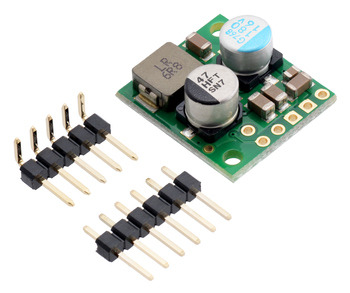 |
|
Step-Down Voltage Regulator D36V28Fx, with included hardware. |
|---|
The six connections are arranged on 0.1″ grid for compatibility with solderless breadboards, connectors, and other prototyping arrangements that use a 0.1″ grid. The PG connection is the only one not located along the edge of the board. A 6×1 straight male header strip and a 5×1 right-angle male header strip are is included with the regulator; one pin of the straight header can optionally be broken off and soldered into PG.
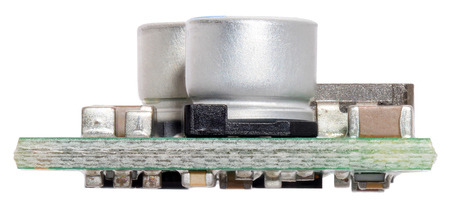 |
|
Step-Down Voltage Regulator D36V28Fx, side view. |
|---|
Typical efficiency
The efficiency of a voltage regulator, defined as (Power out)/(Power in), is an important measure of its performance, especially when battery life or heat are concerns.
 |
Maximum continuous output current
The maximum achievable output current of these regulators varies with the input voltage but also depends on other factors, including the ambient temperature, air flow, and heat sinking. The graph below shows maximum output currents that these regulators can deliver continuously at room temperature in still air and without additional heat sinking.
 |
During normal operation, this product can get hot enough to burn you. Take care when handling this product or other components connected to it.
Quiescent current
The quiescent current is the current the regulator uses just to power itself, and the graph below shows this for the different regulator versions as a function of the input voltage. The module’s EN input can be driven low to put the board into a low-power state where it typically draws between 10 µA and 20 µA per volt on VIN.
 |
Typical dropout voltage
The dropout voltage of a step-down regulator is the minimum amount by which the input voltage must exceed the regulator’s target output voltage in order to ensure the target output can be achieved. For example, if a 5 V regulator has a 1 V dropout voltage, the input must be at least 6 V to ensure the output is the full 5 V. Generally speaking, the dropout voltage increases as the output current increases. The graph below shows the dropout voltages for the different members of this regulator family:
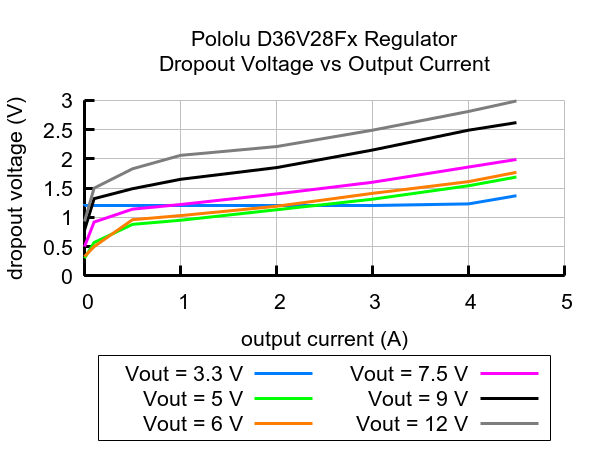 |
Dimensions
| Size: | 0.7″ × 0.8″ × 0.345″1 |
|---|
General specifications
| Minimum operating voltage: | 4.5 V2 |
|---|---|
| Maximum operating voltage: | 50 V |
| Continuous output current: | 3.6 A3 |
| Output voltage: | 3.3 V |
| Reverse voltage protection?: | Y4 |
| Maximum quiescent current: | 3 mA5 |
| Output type: | fixed 3.3V |
Notes:
1. Without included optional headers.
2. Subject to dropout voltage considerations. See the dropout voltage graph under the description tab for more information.
3. Typical continuous output current at 36 V in. Actual achievable continuous output current is a function of input voltage and is limited by thermal dissipation. See the output current graph under the description tab for more information.
4. To -40 V. Connecting supplies over 40 V in reverse can damage the device.
5. While enabled with no load. Can be reduced to under 1 mA using the enable pin.
Enter the code in the box below:
